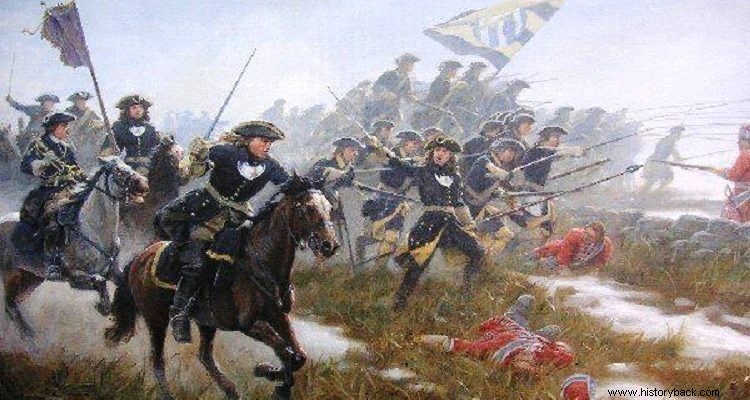
A battle beyond the forces involved in it is primarily the conflict of wills of rival administrations. It is what is often overlooked by some who dream of "people's" armies, the value of command imposing its will on the enemy, disorienting and overwhelming him even if he is outnumbered and outgunned.
The Battle of Fraustad (present-day Pszów in western Poland) is one such example of a conflict where the few, not even possessing artillery, seized the initiative and crushed a force twice their size, fortified and supported by 32 guns, with a double superhorn maneuver such as that of Miltiades in Marathon.
In 1706 the Great Northern War between Sweden, on the one hand, and the alliance of Russia, Saxony-Poland, and Denmark, on the other, was at its height. The Swedish army was small but recognized as perhaps the best in Europe at the time. The King of Saxony had a good army as well, while the Russian army was still in its infancy as a European-style military force.
The united kingdom of Saxony-Poland under the Saxon king Augustus the Strong it had split as many Poles did not wish to have a German king. The rebels called for help from the Swedes who responded. In 1706, the small army of the Swedish marshal Karl Gustav Renskiold was operating in today's western Poland . The term "army" is indulgently excessive for the 9,400 men (3,700 infantry and 5,700 cavalry, no artillery) that Renskiold had at his disposal.
On the contrary, the German (Prussian) general Johann Matthias von de Schulenburg he could look to the future with more optimism as he had 16,000 infantry, of which 6,300 were Russians and the rest Saxons, 4,000 Saxon cavalry and 32 guns. He was expecting his reinforcement with 8,000 more horsemen.
Sullenburg, though outnumbered, decided to lure the Swedes to ground of his choice, so as to force them either to fight there, or to be crushed by his cavalry as soon as they were reinforced. The German general feigned retreat, certain that his impetuous Swedish opponent would follow him.
Arriving in the region of Fraustadt, Schulenburg occupied a strong position and fortified his men by arranging his infantry in two lines of battle, capable of supporting each other. His cavalry flanked him. In front of the site were frozen ponds and marshes. The two ends of his faction rested in the villages of Gegersdorf and Rehrsdorf.
The maneuver of success ala Miltiades
The Swedish general indeed followed the allied army, and arriving, on the 13th of February, before the site began to survey it. He then deployed his mere 3,700 infantry in the center, in three phalanxes, not lines, against five times as many opponents, while he divided his cavalry and deployed them on the flanks of the infantry.
Then the Swedes prayed and moved forward. The plan of the Swedish marshal was a copy of the plan of the Athenian general Miltiades at Marathon, with a weak center and strong wings. It was a classic, now, center denial and double hyperhorn maneuver.
The Swedish cavalry had difficulty crossing the marshes. If the allied army had a good commander the Saxon cavalry should have attacked the Swedes when they had lost their cohesion because of the marshes. However, such a thing did not happen.
So the Swedish cavalry advanced and charged against the Saxon horsemen. The Swedish infantry did not attack. He remained in the center holding back 16,000 opposing infantry whom his commander was afraid to order to attack and overwhelm the Swedish infantry alone with their numerical superiority.
At the same time the Swedish cavalry on the left made one charge after another against the picked Saxon horsemen of the royal guard. Finally, although they fought heroically, the Saxons "broke" and fled. On the Swedish right, Colonel von Krashof's 12 dragoons also overcame the Saxon cavalry and, after moving in depth, turned against the rear of the Russian soldiers of Schulenburg.
The same thing happened to the Swedish left. When the Swedish cavalry charged against the Saxon and Russian infantry they "broke" their panicked formations and fled disorderly like an uncontrollable mass. Then the Swedish infantry also attacked them. The Swedish infantry turned mainly against the Russians, with whom there was a particular hatred, who were also attacked from the rear by the cavalry.
The result was their encirclement and annihilation. The surviving Saxons and Russians fled towards the town of Fraustad, but the Swedish cavalry moved faster than them and found themselves in front of them, cutting their way. At the same time the Swedish infantry were also coming upon them. Having no other choice, thousands laid down their arms and surrendered.
The losses of the defeated were overwhelming. Nearly 7,400 of their men were dead and nearly 8,000 captured. The victorious Swedes had 400 dead and about 1,000 wounded. However, Schulenburg managed to escape, although he was wounded in the... hip.
In the hands of the victors fell 71 flags and banners, all 32 cannons of the opposing army, thousands of muskets and swords. Of the prisoners the Swedes executed 500 Russian prisoners . It is worth noting that the Russians who wore green tunics with red lining, had worn them backwards during the battle to appear as Saxons.

The Swedish infantry of the time had adopted a unique tactic. The men would approach the enemy, launch a salvo against them, and then I would rush out with bayonets and sarissas against them. It was the famous Gå På tactic. Accordingly, the cavalry fought in a wedge formation, like the Companions of Alexander the Great.
